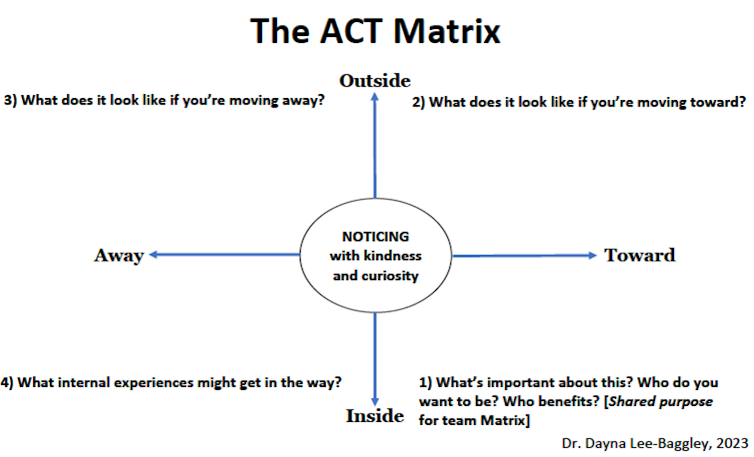is an assistant professor in the Department of Family Medicine & Department of Psychology and Neuroscience at ĖýēđēÔŧåĖý is an associate professor and registered dietitian in the Department of Applied Human Nutrition at .
is May 1 to 6. It offers us a chance to highlight and discuss safety, health and harm prevention in the workplace.
Workplaces have come a long way from a time when safety was equated with physical safety. Occupational health and safety is no longer simply about hardhats and steel-toed work boots â itâs also about .
The emotional well-being of workers is critical to the success of any organization. Psychological safety is everyoneâs responsibility, but hinges on leadership valuing and facilitating it.
Psychological safety
A psychologically safe workplace is one where itâs OK to make mistakes, itâs OK to not be OK, and itâs OK to speak up and disagree with superiors or other members of your team.
A psychologically safe workplace is where without fear of judgment, lateral violence (for example exclusion, bullying) or negative consequences.
A research initiative undertaken by Google called identified psychological safety as the single .
The project was named after the ancient Greek philosopher Aristotle, who once said âthe whole is greater than the sum of its parts.â Aristotle suggested that people who worked together could achieve better results than working alone.
The researchers looked at a range of factors, including team size, member diversity, communication styles and leadership, among others.
Amid worldwide concerns about a and accessibility, and productivity and , committing to creating psychologically safe workplaces is the best way to help employees and teams function most effectively.
Benefits of psychological safety
Current evidence supports that psychological safety is positively associated with â all favourable outcomes for institutions, organizations, the bottom line, clients and the larger community.
These benefits can be obtained through the creation and maintenance of workplaces where employees are able to express themselves, are treated with respect and dignity, and do not experience hierarchical or lateral violence that can include bullying and exclusion.
Creating and maintaining a psychologically safe environment results in employees who are more likely to and . Choosing psychological safety is choosing to move away from shame and blame and move towards a culture of inclusion, openness and learning.

Several recent surveys on disability claims exemplify why employers should invest in employee psychological health and safety.
Telus Health reported that short-term disability claims, due to mental health, .
Deloitte found that 30 to 40 per cent of short-term disability claims were due to . According to data from Canadian Life and Health Insurance Association members, claims for mental health supports .
More and more employees consider workplace mental health support a key factor in whether they apply for and accept jobs. A reported that 81 per cent of survey respondents agreed that employer support for mental health was an important consideration in their job search.
In addition, 30 per cent of respondents strongly agreed that employer support for mental health factored into their job decisions, which increased retention. In a challenging labour market, fostering psychological health and safety is key to attracting and keeping talent.
Psychological safety in ACTion
While itâs clear psychological safety benefits employees and employers, fostering it requires a commitment to learning, unlearning and collaboratively facilitating change over time.
Creating psychological safety also requires a specific set of skills that many workplaces are ill-equipped to foster in leaders and in employees.
The Acceptance and Commitment Therapy (ACT) Matrix is an evidence-based tool designed to help people develop â the ability to adapt and respond effectively to changing situations and circumstances.
Psychological flexibility includes having the ability to choose our actions, despite difficult inner thoughts and emotions like anger and feelings of distrust.

The individual ACT Matrix provides a framework for increasing psychological flexibility, fostering behaviour change and increasing actions that are consistent with our values. It can be an effective intervention for promoting psychological safety in the workplace.
The focuses on having a shared purpose (shared values) to orient how members of a team from shared purpose. It builds psychological safety by providing a way to communicate respectfully about difficult topics.
The ACT Matrix can increase psychological , , and and reduce and emotional .
Strategies rooted in ACTion
The ACT Matrix provides us with several practical strategies for building psychological safety:
1) Notice your internal thoughts, feelings, and sensations. Notice how they impact your behaviour in the upper quadrant (for example, do they shut you down? Do you start avoiding or criticizing?). Name them and normalize them. By sharing our observations of our internal experiences, we can normalize them with others and build safety to âbe OK not to be OK.â By connecting internal experiences to our behaviour, we can pause and make choices about how we want to show up.
2) Consider choices in terms of âmoving towardsâ or âmoving awayâ from your values, instead of good and bad, right and wrong, or true and false. This is different than setting goals or creating action plans. There is no finish line for psychological safety, we just keep trying to make moves âtowardâ or contributing to psychological safety.

3) Discuss difficult topics with colleagues in terms of a âshared purpose.â Framing a discussion in terms of shared purpose puts everyone on the same side and allows everyone to come up with behaviours that make sense in the situation and for the people involved. It can also help employees understand the reason behind a colleagueâs behaviour (in other words, they may consider that behaviour a move âtowardsâ a shared purpose). This allows us to be our authentic selves in the workplace.
4) We can use the ACT Matrix to identify and name lateral violence in the workplace as âaway moves.â Lateral violence equates to a psychologically unsafe environment. This can be bullying, exclusion or freezing people out, belittling othersâ opinions, snide comments or remarks, gossiping, mobbing or sharing personal information. Colleagues may not recognize the impact of their behaviour on others. The ACT Matrix allows us to bring up such sensitive topics in the framework of âtowardsâ and âawayâ moves.
By making use of the ACT Matrix, the complex skills of building psychological safety are broken down into practical steps that can be learned and practised over time.
In this way, employees and employers can take meaningful steps together toward fostering psychological safety in the workplace.
Ron Pizzo, an employment lawyer, co-authored this article.![]()
This article is republished from under a Creative Commons license. Read the .

